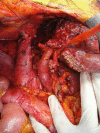Multivisceral resection of pancreatic neuroendocrine tumours: a report of two cases
- PMID: 21859472
- PMCID: PMC3175454
- DOI: 10.1186/1477-7819-9-93
Multivisceral resection of pancreatic neuroendocrine tumours: a report of two cases
Abstract
Pancreatic neuroendocrine tumours (pNETs) are rare and surgical resection offers the only possibility of cure for localised disease. The role of surgery in the setting of locally advanced and metastatic disease is more controversial. Emerging data suggests that synchronous surgical resection of pancreas and liver may be associated with increased survival. We report two cases of synchronous, one stage multivisceral resections for pNET and associated reconstruction. We highlight the technical issues involved in such extensive resections and demonstrate that one stage multivisceral operations can be achieved safely.
Figures






References
Publication types
MeSH terms
LinkOut - more resources
Full Text Sources
Medical

